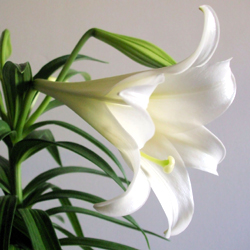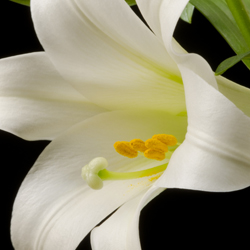Historically, ancient myths and allegories used white lilies as symbols of purity, virtue, rebirth, motherhood and joy. Roman mythology claims lilies sprang up where drops of Juno’s milk dripped while nursing her son, Hercules. Christian churches use the lily at Easter, continuing the tradition that white lilies grew where drops of Christ’s sweat fell in the Garden of Gethsemane to commemorate his resurrection and hope of life everlasting.
The Easter lily, Lilium longiflorum, is actually native to the Ryukyu Islands in southern Japan. Carl Peter Thunberg, among his many other discoveries, identified it in 1777, and sent bulbs to England in 1819. In the mid-1800s, bulbs were sent to Bermuda for commercial propagation, and it gained the name of “Bermuda lily.” The flowers bloomed there in spring. Later, when a woman from Philadelphia took bulbs back home, she was disappointed to find it bloomed there in summer. A local florist began forcing the bulbs to bloom in the spring for Easter. Thus, the term “Easter lily” emerged. In 1898, after a virus destroyed the Bermuda crops, production and export resumed in Japan.
World War I interrupted the US import business. However, as in all good stories, there was a hero. Soldier Louis Houghton smuggled a suitcase of bulbs to Oregon where plant enthusiasts began growing them. Some sold bulbs for profit even after the war ended and trade resumed. When WWII interrupted the import of bulbs, and the prices skyrocketed, these enthusiasts supplied bulbs to US growers and the flowers became “white gold.”
And now? A small area on the California-Oregon border known as the “Easter Lily Capital of the World” grows 95% of all Easter lily bulbs. Although there were more than 1,200 growers in a much larger area, ten growers comprise the present Pacific Bulb Growers Association, producing more than 65,000 boxes of bulbs sent all over the world. In fact, in 1996, over 11.5 million bulbs were dug and shipped to commercial greenhouses to pot and grow under exacting conditions to sell at Easter time.
Therefore, in all likelihood, your Easter lilies began their lives as tiny bulbs from one of those ten growers. In fact, your cultivar is probably a “Nellie White,” developed by grower James White who named it after his wife.
So, now that you know the history of your Easter lily, what can you do to prolong its life with you?
While blooming:
- Removing the yellow anthers from the flower center makes the flower last longer. Remove flowers when no longer attractive.
- Place in indirect/bright light where daytime temperatures are 60-65⁰F.
- Keep away from hot and cold drafts.
- Water when soil is dry to the touch (be sure to remove any gift foil so water may drain away).
Because Easter lilies are hardy when given minimal protection, plant outdoors after the last frost.
- Chose a sunny location with rich well-draining soil. If your soil doesn’t drain well, create a raised bed, as excessive water will rot the bulbs.
- Dig a hole 6″ deep and 6″ across with a 2″ high mound in the middle. (If transplanting more than one, allow 18″ between holes)
- Place the bulb on the mound and spread the roots down the sides of the mound.
- Work enriched soil around the mound and bulb, tamping gently to remove air pockets.
- Water well. Mulch to maintain a lower soil temperature or underplant with low growing and shallow rooting annual or perennials such as violets or vincas.
- Cut the stems back to the soil surface as they shrivel and dry.
- They may bloom again in late summer on new growth or they will bloom the following June or July.
- In late fall, provide winter soil protection with mulch or straw and pull back in the spring.
Enjoy the beauty and fragrance for many years to come.



